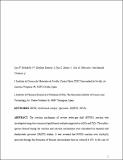Por favor, use este identificador para citar o enlazar a este item:
http://hdl.handle.net/10261/169525COMPARTIR / EXPORTAR:
 SHARE SHARE
 CORE
BASE CORE
BASE
|
|
| Visualizar otros formatos: MARC | Dublin Core | RDF | ORE | MODS | METS | DIDL | DATACITE | |

| Campo DC | Valor | Lengua/Idioma |
|---|---|---|
| dc.contributor.author | Bobadilla, Luis F. | es_ES |
| dc.contributor.author | Ivanova, Svetlana | es_ES |
| dc.contributor.author | Santos, José L. | es_ES |
| dc.contributor.author | Odriozola, José Antonio | es_ES |
| dc.contributor.author | Urakawa, Atsushi | es_ES |
| dc.date.accessioned | 2018-09-10T10:21:28Z | - |
| dc.date.available | 2018-09-10T10:21:28Z | - |
| dc.date.issued | 2018-07 | - |
| dc.identifier.citation | ACS Catalysis, 8(8): 7455-7467 (2018) | es_ES |
| dc.identifier.uri | http://hdl.handle.net/10261/169525 | - |
| dc.description.abstract | The reaction mechanism of the reverse water–gas shift (RWGS) reaction was investigated using two commercial gold-based catalysts supported on Al2O3 and TiO2. The surface species formed during the reaction and reaction mechanisms were elucidated by transient and steady-state operando DRIFTS studies. It was revealed that RWGS reaction over Au/Al2O3 proceeds through the formation of formate intermediates that are reduced to CO. In the case of the Au/TiO2 catalyst, the reaction goes through a redox mechanism with the suggested formation of hydroxycarbonyl intermediates, which further decompose to CO and water. The Ti3+ species, the surface hydroxyls, and oxygen vacancies jointly participate. The absence of carbonyl species adsorbed on gold particles during the reaction for both catalysts indicates that the reaction pathway involving dissociative adsorption of CO2 on Au particles can be discarded. To complete the study, operando ultraviolet–visible spectroscopy was successfully applied to confirm the presence of Ti3+ and to understand the role of the oxygen vacancies of TiO2 support in activating CO2 and thus the subsequent RWGS reaction. | es_ES |
| dc.language.iso | eng | es_ES |
| dc.publisher | American Chemical Society | es_ES |
| dc.relation.isversionof | Postprint | es_ES |
| dc.rights | openAccess | en_EN |
| dc.subject | RWGS | es_ES |
| dc.subject | Gold-based catalyst | es_ES |
| dc.subject | Operando | es_ES |
| dc.subject | DRIFTS | es_ES |
| dc.subject | UV-Vis | es_ES |
| dc.title | Unravelling the Role of Oxygen Vacancies in the Mechanism of the Reverse Water-Gas-Shift Reaction by Operando DRIFTS and UV-Vis Spectroscopy | es_ES |
| dc.type | artículo | es_ES |
| dc.identifier.doi | 10.1021/acscatal.8b02121 | - |
| dc.description.peerreviewed | Peer reviewed | es_ES |
| dc.relation.publisherversion | https://doi.org/ 10.1021/acscatal.8b02121 | es_ES |
| dc.embargo.terms | 2019-07-02 | es_ES |
| dc.relation.csic | Sí | es_ES |
| oprm.item.hasRevision | no ko 0 false | * |
| dc.contributor.orcid | Bobadilla, L. F. [0000-0003-0085-9811] | es_ES |
| dc.type.coar | http://purl.org/coar/resource_type/c_6501 | es_ES |
| item.openairecristype | http://purl.org/coar/resource_type/c_18cf | - |
| item.fulltext | With Fulltext | - |
| item.cerifentitytype | Publications | - |
| item.openairetype | artículo | - |
| item.languageiso639-1 | en | - |
| item.grantfulltext | open | - |
| Aparece en las colecciones: | (ICMS) Artículos | |
Ficheros en este ítem:
| Fichero | Descripción | Tamaño | Formato | |
|---|---|---|---|---|
| Manuscript final accepted.pdf | 2,81 MB | Adobe PDF |  Visualizar/Abrir |
CORE Recommender
SCOPUSTM
Citations
168
checked on 12-abr-2024
WEB OF SCIENCETM
Citations
148
checked on 27-feb-2024
Page view(s)
499
checked on 17-abr-2024
Download(s)
622
checked on 17-abr-2024
Google ScholarTM
Check
Altmetric
Altmetric
NOTA: Los ítems de Digital.CSIC están protegidos por copyright, con todos los derechos reservados, a menos que se indique lo contrario.
